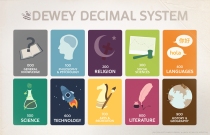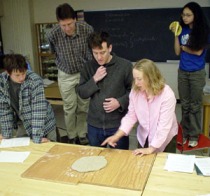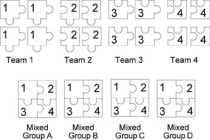Posts Tagged: Ideas

Defining Research Questions
Selecting aspects of a topic to research can be tough, especially for younger students who may, without guidance, collect a mishmash of random, unrelated facts. This handout and activity helps students pick research questions that are relevant to them and

Defining Research Questions
Selecting aspects of a topic to research can be tough, especially for younger students who may, without guidance, collect a mishmash of random, unrelated facts. This handout and activity helps students pick research questions that are relevant to them and

Ten Techniques to Make Yourself a Google Search Star
Access the resource by clicking on the picture or here. Richard Byrne, the blogger behind the award-winning Free Technology for Teachers, has created a poster that can be printed and distributed to students or hung that outlines how to effectively

Ten Techniques to Make Yourself a Google Search Star
Access the resource by clicking on the picture or here. Richard Byrne, the blogger behind the award-winning Free Technology for Teachers, has created a poster that can be printed and distributed to students or hung that outlines how to effectively

A-Ha! Mm-Hmm…Say What? Discussion
This is a way to frame discussion on an article that the class reads. With their notes on the reading, students work in small groups to identify each of these moments they had while reading: A-Ha: A new idea that

A-Ha! Mm-Hmm…Say What? Discussion
This is a way to frame discussion on an article that the class reads. With their notes on the reading, students work in small groups to identify each of these moments they had while reading: A-Ha: A new idea that

Choosing the Best Search Resource for Your Information Need
Noodle Tools is a website that provides information literacy resources. “Choosing the Best Search for Your Information Need” helps users who are looking for specific information use the correct search engine or website resource. The page is separated by topic,

Choosing the Best Search Resource for Your Information Need
Noodle Tools is a website that provides information literacy resources. “Choosing the Best Search for Your Information Need” helps users who are looking for specific information use the correct search engine or website resource. The page is separated by topic,

Hoax? Scholarly Research? Personal Opinion? You Decide! Lesson
The lesson can be found in a variety of different formats online. To download a lesson plan, click here. To see the lesson plan in a webpage format, click here. This lesson asks students to evaluate a series of websites

Hoax? Scholarly Research? Personal Opinion? You Decide! Lesson
The lesson can be found in a variety of different formats online. To download a lesson plan, click here. To see the lesson plan in a webpage format, click here. This lesson asks students to evaluate a series of websites

Library Session (One-Shot) Assessment Survey
Click this link for the survey described below. Found through the S.O.S. for Information Literacy database, the Cornell University Library offers one web example of an evaluation for a one-shot workshop session. It has ten questions that include scale multiple-choice

Library Session (One-Shot) Assessment Survey
Click this link for the survey described below. Found through the S.O.S. for Information Literacy database, the Cornell University Library offers one web example of an evaluation for a one-shot workshop session. It has ten questions that include scale multiple-choice

Symbaloo via The Unquiet Librarian blog
Symbaloo allows a user to create a customizable dashboard of websites and resources in order to create a personal learning environment. Buffy Hamilton, blogger of The Unquiet Librarian, uses Symbaloo with her high school students in conjunction with an English

Symbaloo via The Unquiet Librarian blog
Symbaloo allows a user to create a customizable dashboard of websites and resources in order to create a personal learning environment. Buffy Hamilton, blogger of The Unquiet Librarian, uses Symbaloo with her high school students in conjunction with an English

Rotating tables
ROTATING TABLES ACTIVITY: An activity designed to have both group and class involvement, as well as collaboration on different aspects of one topic: Assign a topic and break into 4-5 subtopics, or questions related to the topic Each group is

Rotating tables
ROTATING TABLES ACTIVITY: An activity designed to have both group and class involvement, as well as collaboration on different aspects of one topic: Assign a topic and break into 4-5 subtopics, or questions related to the topic Each group is

One Minute Paper
One minute papers can be used as informal or formal assessment tools at the end of an instructional session or class. This is an example of an exit ticket that students are required to turn in before they exit the

One Minute Paper
One minute papers can be used as informal or formal assessment tools at the end of an instructional session or class. This is an example of an exit ticket that students are required to turn in before they exit the

Sliding Groups
This activity is used to switch up small group discussion that involves multiple questions. Small groups of any number start by discussing one question. Then, the instructor reads a statement or a statement is displayed on the board in which

Sliding Groups
This activity is used to switch up small group discussion that involves multiple questions. Small groups of any number start by discussing one question. Then, the instructor reads a statement or a statement is displayed on the board in which

Musical Chairs Response
This activity can be used as a way for students to respond to their peers’ work. First, each student writes out a question or concept at their own seat. The teacher then starts music and all students walk (or dance)

Musical Chairs Response
This activity can be used as a way for students to respond to their peers’ work. First, each student writes out a question or concept at their own seat. The teacher then starts music and all students walk (or dance)

Learning Dewey Decimal
This is an activity to help students understand why books are shelved in certain areas and have certain call numbers. Separate students in groups of 3-6. Provide each group with a bag of library books labeled with the Dewey Decimal

Learning Dewey Decimal
This is an activity to help students understand why books are shelved in certain areas and have certain call numbers. Separate students in groups of 3-6. Provide each group with a bag of library books labeled with the Dewey Decimal

Learner Response Systems
These devices, sometimes called clickers, are used for immediate engagement and assessment for a whole class. The instructor can use software to prepare questions to ask during class, or if needed, can instantly create a question during instruction to check

Learner Response Systems
These devices, sometimes called clickers, are used for immediate engagement and assessment for a whole class. The instructor can use software to prepare questions to ask during class, or if needed, can instantly create a question during instruction to check

Gallery Walk
A gallery walk a way to share student work with the rest of the class without a traditional presentation. Post all student work around the perimeter of the room – on tables or walls – and allow students to browse

Gallery Walk
A gallery walk a way to share student work with the rest of the class without a traditional presentation. Post all student work around the perimeter of the room – on tables or walls – and allow students to browse

Wall of Words
WALL OF WORDS Also sometimes called “All on the Wall” This is an activity where several related prompts may be written on the board, and each student is handed a whiteboard marker or chalk (depending on the board) and is

Wall of Words
WALL OF WORDS Also sometimes called “All on the Wall” This is an activity where several related prompts may be written on the board, and each student is handed a whiteboard marker or chalk (depending on the board) and is

What? / So What? / Now What?
What? / So What? / Now What? This activity can be given to students for a topic that needs to be critically evaluated. Ask the students these three questions: What? Descriptive – what is the problem, issue, circumstance, etc.? So

What? / So What? / Now What?
What? / So What? / Now What? This activity can be given to students for a topic that needs to be critically evaluated. Ask the students these three questions: What? Descriptive – what is the problem, issue, circumstance, etc.? So

Concept Mapping
CONCEPT MAPPING: Also called concept webbing, spider diagram, etc. Concept mapping is another graphic organizer for ideas. This activity is flexible because it can be done alone or in a group, and promotes critical thinking about how ideas connect and

Concept Mapping
CONCEPT MAPPING: Also called concept webbing, spider diagram, etc. Concept mapping is another graphic organizer for ideas. This activity is flexible because it can be done alone or in a group, and promotes critical thinking about how ideas connect and

Definition Four-Square (Frayer Model)
DEFINITION FOUR SQUARE: A graphic organizer based on the Frayer Model –> Select a key concept, idea or term to define. Have students divide a large page, or space on a white board into 4 sections. Title the sections as:

Definition Four-Square (Frayer Model)
DEFINITION FOUR SQUARE: A graphic organizer based on the Frayer Model –> Select a key concept, idea or term to define. Have students divide a large page, or space on a white board into 4 sections. Title the sections as:

Assigning Group Roles
ASSIGNING GROUP ROLES Assigning group roles is a good way to make sure that each student is on task, has a sense of importance to the group and can contribute to a class project or discussion. Making each student

Assigning Group Roles
ASSIGNING GROUP ROLES Assigning group roles is a good way to make sure that each student is on task, has a sense of importance to the group and can contribute to a class project or discussion. Making each student

Double Pyramid Activity
Double Pyramid Note Cards – Group Activity: Students divide into small groups of 4-5 and are given a set of note cards with evaluative statements about a topic prepared ahead of time by a teacher or librarian. Students evaluate each

Double Pyramid Activity
Double Pyramid Note Cards – Group Activity: Students divide into small groups of 4-5 and are given a set of note cards with evaluative statements about a topic prepared ahead of time by a teacher or librarian. Students evaluate each

Reading Jigsaw
This activity should be used when you have a large chunk of text with concepts that you want students to understand, but don’t necessarily need each student to read the entire text independently. It has three parts: one the teacher

Reading Jigsaw
This activity should be used when you have a large chunk of text with concepts that you want students to understand, but don’t necessarily need each student to read the entire text independently. It has three parts: one the teacher

Think-Pair-Share
A way to facilitate discussion in class. Think: Have students independently consider a question or prompt for 1-2 minutes. Pair: Then have students turn to their neighbor and talk about their answers for 1-2 minutes. Share: Come back together as

Think-Pair-Share
A way to facilitate discussion in class. Think: Have students independently consider a question or prompt for 1-2 minutes. Pair: Then have students turn to their neighbor and talk about their answers for 1-2 minutes. Share: Come back together as

Rock Paper Scissors Icebreaker
In this icebreaker, students place Rock, Paper, Scissors against each other. When one player wins, the other player follows the winner to a new game, chanting the winner’s name. This process continues until there are only two players left. At

Rock Paper Scissors Icebreaker
In this icebreaker, students place Rock, Paper, Scissors against each other. When one player wins, the other player follows the winner to a new game, chanting the winner’s name. This process continues until there are only two players left. At